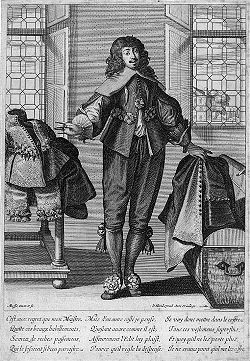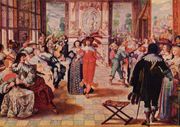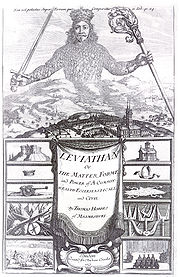
Abraham Bosse
Encyclopedia

French art
French art consists of the visual and plastic arts originating from the geographical area of France...
ist, mainly as a printmaker in etching
Etching
Etching is the process of using strong acid or mordant to cut into the unprotected parts of a metal surface to create a design in intaglio in the metal...
, but also in watercolour
Watercolor painting
Watercolor or watercolour , also aquarelle from French, is a painting method. A watercolor is the medium or the resulting artwork in which the paints are made of pigments suspended in a water-soluble vehicle...
.
Life
He was born to HuguenotHuguenot
The Huguenots were members of the Protestant Reformed Church of France during the 16th and 17th centuries. Since the 17th century, people who formerly would have been called Huguenots have instead simply been called French Protestants, a title suggested by their German co-religionists, the...
(Calvinist
Calvinism
Calvinism is a Protestant theological system and an approach to the Christian life...
) parents in Tours
Tours
Tours is a city in central France, the capital of the Indre-et-Loire department.It is located on the lower reaches of the river Loire, between Orléans and the Atlantic coast. Touraine, the region around Tours, is known for its wines, the alleged perfection of its local spoken French, and for the...
, France, where his father had moved from Germany. His father was a tailor, and Bosse's work always depicted clothes in loving detail http://expositions.bnf.fr/bosse/grand/017.htm. He married Catherine Sarrabat at Tours in 1632. He remained a Huguenot, dying before the Revocation of the Edict of Nantes, but was happy to illustrate religious subjects to Catholic
Roman Catholic Church
The Catholic Church, also known as the Roman Catholic Church, is the world's largest Christian church, with over a billion members. Led by the Pope, it defines its mission as spreading the gospel of Jesus Christ, administering the sacraments and exercising charity...
taste http://expositions.bnf.fr/bosse/grand/118.htm.
Work
Roughly 1600 etchings are attributed to him, with subjects including: daily life http://expositions.bnf.fr/bosse/grand/074.htm, religion http://expositions.bnf.fr/bosse/grand/109.htm, literaturehttp://expositions.bnf.fr/bosse/grand/106.htm, history http://expositions.bnf.fr/bosse/grand/168.htm, fashion http://expositions.bnf.fr/bosse/grand/040.htm, technology http://expositions.bnf.fr/bosse/grand/215.htm, and science http://expositions.bnf.fr/bosse/grand/195.htm. Most of his output was illustrations for books, but many were also sold separately. His style grows from Dutch
Dutch art
Dutch art describes the history of visual arts in the Netherlands, after the United Provinces separated from Flanders. Earlier painting in the area is covered in Early Netherlandish painting and Renaissance art.-Golden Age:...
and Flemish art
Flemish painting
Flemish painting flourished from the early 15th century until the 17th century. Flanders delivered the leading painters in Northern Europe and attracted many promising young painters from neighbouring countries. These painters were invited to work at foreign courts and had a Europe-wide influence...
, but is given a strongly French flavour. Many of his images give fascinating and informative detail about middle and upper-class daily life in the period, although they must be treated with care as historical evidence http://expositions.bnf.fr/bosse/grand/081.htm. His combination of very carefully depicted grand interiors with relatively trivial domestic subjects http://expositions.bnf.fr/bosse/grand/070.htm was original and highly influential on French art, and also abroad — William Hogarth
William Hogarth
William Hogarth was an English painter, printmaker, pictorial satirist, social critic and editorial cartoonist who has been credited with pioneering western sequential art. His work ranged from realistic portraiture to comic strip-like series of pictures called "modern moral subjects"...
's engravings are, among other things, a parody of the style. Most of his images are perhaps best regarded as illustrations rather than art.

Paris
Paris is the capital and largest city in France, situated on the river Seine, in northern France, at the heart of the Île-de-France region...
about 1620 to the Antwerp-born engraver Melchior Tavernier (1564–1641), who was also an important publisher. His first etchings date to 1622, and are influenced by Jacques Bellange
Jacques Bellange
Jacques Bellange was an artist and printmaker from the Duchy of Lorraine whose etchings and some drawings are his only securely identified works today. They are among the most striking Mannerist old master prints, mostly on Catholic religious subjects, and with a highly individual style...
. Following a meeting in Paris about 1630, he became a follower of Jacques Callot
Jacques Callot
Jacques Callot was a baroque printmaker and draftsman from the Duchy of Lorraine . He is an important figure in the development of the old master print...
, whose technical innovations in etching he popularised in a famous and much translated Manual of Etching(1645), the first to be published http://expositions.bnf.fr/bosse/grand/209.htm. He took Callot's highly detailed small images to a larger size, and a wider range of subject matter.
Unlike Callot, his declared aim, in which he largely succeeded, was to make etchings look like engraving
Engraving
Engraving is the practice of incising a design on to a hard, usually flat surface, by cutting grooves into it. The result may be a decorated object in itself, as when silver, gold, steel, or glass are engraved, or may provide an intaglio printing plate, of copper or another metal, for printing...
s, to which end he sacrificed willingly the freedom of the etched line, whilst certainly exploiting to the full the speed of the technique. Like most etchers, he frequently used engraving on a plate in addition to etching, but produced no pure engravings.
Controversy
In 1641 he began to attend classes given by the architect Girard Desargues (1591–1661) on perspective and other technical aspects of depiction. Bosse not only adopted these methods but also published a series of works between 1643–1653 explaining and promoting them http://expositions.bnf.fr/bosse/grand/278.htm.In 1648, when Cardinal Mazarin established the Académie royale de peinture et de sculpture, Bosse was made a founding member. However his publicising of Desargues' methods embroiled him in a controversy with Charles Le Brun
Charles Le Brun
Charles Le Brun , a French painter and art theorist, became the all-powerful, peerless master of 17th-century French art.-Biography:-Early life and training:...
and his followers who had different methods, and also a belief that "genius" rather than technical method should be the guide in creating artworks. In 1661 Bosse was forced to withdraw from the Academy; he established his own school as an alternative.
Etchings & Images

- Plates for (1639) (1643), printed by P. de Hayes, Paris (1643)
- De la manière de graver à l'eaux-forte et au burin (1645) (1645) The "Manual of Etching". (1648) — Manual on perspective (1653)
- The famous frontispiece for LeviathanLeviathan (book)Leviathan or The Matter, Forme and Power of a Common Wealth Ecclesiasticall and Civil — commonly called simply Leviathan — is a book written by Thomas Hobbes and published in 1651. Its name derives from the biblical Leviathan...
by Thomas HobbesThomas HobbesThomas Hobbes of Malmesbury , in some older texts Thomas Hobbs of Malmsbury, was an English philosopher, best known today for his work on political philosophy...
(1651) was created with input from Hobbes. - Plates for (1656) (1664) — Architecture (1665)
Later Collections
- Die Kunst, in Kupfer zu stechen, Ilmer, Osnabrück 1975 (Repr. d. Ausg. Nürnberg 1765)
- Radier-Büchlein. Handelt von der Etzkunst, nemlich wie man mit Scheidwasser in Kupfer etzen, das Wasser und wie auch den harten und weichen Etzgrund machen solle, Moos, München 1977, ISBN 3-7879-0088-8 (Repr. d. Ausg. Nürnberg 1689)
External links
- Dossier on Abraham Bosse by the French ministry of culture. (in French)
- http://expositions.bnf.fr/bosse/index.htm BNF exhibition feature, with many images & much text in French — click for image galleries, then choose from menu on left

